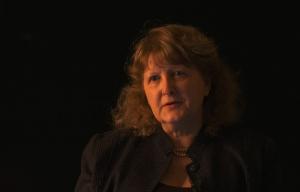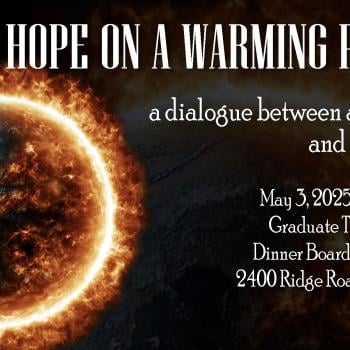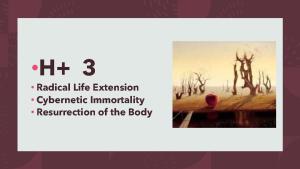 Radical Life Extension? Cybernetic Immortality? Or Resurrection of the Body?
Radical Life Extension? Cybernetic Immortality? Or Resurrection of the Body?
H+ 3 / 1013
Which do you prefer: radical life extension? Cybernetic immortality? Resurrection of the body? Or, just death as endless oblivion?
Transhumanism — also known as Humanity Plus or H+ — plans to solve all human problems with advances in AI (Artificial Intelligence). One H+ goal is to cure death. Without the threat of death, we could elect to live forever. Either in your body or in disembodied form. Are you interested?
Here are four options. Check the box you prefer.
□ 1 Natural death as the end of all conscious existence.
□ 2 Radical Life Extension (RLE) in your present body.
□ 3 Cybernetic Immortality (CI): your consciousness lives on in the computer cloud.
□ 4 Resurrection of the body as promised in 1 Corinthians 15.
In this post the public theologian will explore the contrast between radical life extension and resurrection in light of transhumanist promises. Whether via Radical Life Extension in the body or Cybernetic Immortality in disembodied form, enhanced human intelligence and consciousness have an unending future. So we are promised. Should we trust this techno-promise? Or, should we trust God’s promise of resurrection from the body, the soma pneumatikon? What does it take for us greet the end of life with contentment?
Tracy Trothen and Calvin Mercer are the indefatigable chroniclers of the interaction between Religion and the Technological Future.
Here, in this H+ 3 post, I offer the third in a series of column posts tackling the religious, ethical, and social concerns raised by genetic engineering, AI (artificial intelligence), IA (intelligence amplification), transhumanism, and posthumanism. First, we asked: H+ 1: Is AI a shortcut to virtue? Or to holiness? Then, secondly, we examined varieties of religious transhumanism in the post: H+ 2: The Transhuman, the Posthuman, and the Truly Human. Here we take up one specific issue: how do we compare multiple scenarios for life extension and immortality?
1 Death as Oblivion
Death is natural, right? Death “is the irreversible cessation of the processes that keep the body working,” observes physicist and theologian John Polkinghorne. ”Death really is the end. It’s annihilation” (Polkinghorne 2019, 49). With death comes oblivion.

Yet, the prospect of falling from existence into non-existence at the moment of death issues forth in anxiety. “In the anxiety of having to die nonbeing is experienced from the inside,” says theologian Paul Tillich. “This anxiety is potentially present in every moment. It permeates the whole of man’s being; it shapes soul and body and determines spiritual life; it belongs to the created character of being quite apart from estrangement and sin” (Tillich 1951-1963, 1:193-194).
Is death a disease that needs to be cured? Bioethicist Gilbert Meilaender denies that aging and death belong in the disease category. “Unlike disease,” he says, “aging is a natural stage of life that seems built in” (Meilaender 2013, 2). We should live within the limits of death and aging by cultivating the virtue of patience.
If you check this first option, you elect to end your embodied consciousness and to drop from being into nonbeing. Can you be patient with this?
2 Radical Life Extension (RLE)
Transhumanists define death as a disease. Like other diseases, medical science will cure death. Then, we can live in our present bodies indefinitely.
One clarification. Let’s distinguish between the aim of longevity research (LR) and radical life extension (RLE). LR is being pursued by the Buck Institute, Geron Corporation, Michael D. West’s Therapeutics, and other laboratories. Both LR and RLE belong to the prolongevity club. Note that LR is modest while H+ RLE is dramatic. Big bucks finance both. (Photo: Aubrey de Grey)
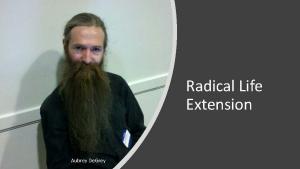
Oxford transhumanist Nick Bostrom sells stock in both LR and RLE because of the “potentially enormous returns, in terms of human welfare, to investment in biogerontological research if it could lead to a further significant extension of the human health span.”
Cambridge geneticist and biogerontologist Aubrey deGrey proclaims that science must triumph over what has hitherto been nature’s province, namely, aging and natural death. “There is a good chance aging can be entirely defeated within the next few decades,” de Grey writes. The speed of speed is speeding up, meaning that the relevant laboratory research is advancing at an increasingly rapid pace. The “longevity escape velocity” or LEV is spiraling upward (DeGrey 2009, 21).
In the race for a life of a thousand years, the runner still needs to dodge incidental death threats. Referring to RLE as practical immortality, Calvin Mercer and Tracy Trothen alert us to remain alert. “Practical immortality means that one will not die from internal biological causes that have been associated with aging, but one could still die of such things as accidental causes, a new infectious disease, natural disasters, or a cosmic event” (C. a. Mercer 2021, 72).
Radical life extension consists of the prolongation of terrestrial embodied living as we have known it minus the deterioration of aging and the portent of an end to life. Unless we get run over by a bus or shot in a war, we can expect over the centuries an unending number of stints on the altar guild or picnics with the PTA. Are you ready for this?
3 Cybernetic Immortality (CI)
RLE is embodied immortality. Cybernetic immortality or digital immortality is disembodied.

The aim of the cybernetic prolongevists is to dislodge our consciousness and our intelligence from our biological substrate and upload it into a computer. As long as the computer battery remains charged, we will live in a disembodied electronic cloud virtually forever. Immortality can be attained here by uploading the information stored in our brain, a process called whole brain emulation.
How might whole brain emulation work? Cybernetic immortality could be attained, according to computer whiz Ray Kurzweil, because intelligence is not dependent upon our biological substrate. Kurzweil, transhumanist in mind-set even if not in name, defines intelligence as an information pattern and, as an information pattern, our intelligence could be transferred from our brain to a computer. The current substrate that houses this information pattern is our body, the eighty to ninety billion neurons in our brain. Could this neuronal information be transferred to a disembodied digital substrate? Yes, say transhumanists.
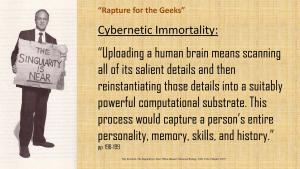
Our intelligence can live on in an enhanced form even when extricated from our bodies and placed in a computer. “Uploading a human brain means scanning all of its salient details and then reinstantiating those details into a suitably powerful computational substrate. This process would capture a person’s entire personality, memory, skills, and history” (Kurzweil 2005, 198-199). From Kurzweil’s forecast of the Singularity by the year 2045, today’s 2045 Initiative has begun to organize the research.
Kurzweil, like others in the H+ movement, plans to derive Homo cyberneticus from modifying Homo sapiens. Once our minds are uploaded, we will become a new species, a posthuman species. The present generation giving birth to the future posthuman species is made up of the transhumanists.
Have we seen this before? Remember René Descartes (1596-1650)? Descartes was a substance dualist. Our body is a physical substance while are mind or soul is a spiritual substance. By performing a soulechtomy, God could extract the soul from its physical housing, said Descartes. Now the transhumanist can do what before only God could do, allegedly.
Would you like to live indefinitely bodiless in the computer cloud?
A Buddhist Reaction to RLE and CI
Neela Bhattacharya Saxena does not find radical life extension or cybernetic immortality inviting. Why? Because extending life as we know it does not include any soteriology. It merely extends the life of struggle we currently undergo.
“The problem with cybernetic immortality, in my judgment, is that it promises only more of the same…namely, a life of stress, struggle, and frustration at our failure to fulfill our cravings even when, and in fact, sometimes in spite of living in the midst of plenty….but the question remains whether there will be freedom from want and suffering in such as future. To attain inner tranquility and discover a dynamic source of joy in existence, I believe, we need to turn toward the penetrating wisdom of Buddha’s vision where nothing is negated, where obscurations of the mind are transmuted into luminous awareness of the in-between.”(Saxena, 2020, p. 74)
The transhumanist promise is not the Buddha’s promise. Saxena chooses the latter.
Are Promises of RLE and CI Realistic?
Is it realistic to anticipate the defeat of death and unending finite life? This question must be addressed on two levels, one psychological and the other scientific.

A curious argument has broken out over the psychological acceptance of living indefinitely. Transhumanists are convinced that nobody wants to die. The transhumanists are probably right on this point.
But, does it follow that everybody wants to life forever? This, it turns out, is a matter of debate. University of Liverpool philosopher Michael Hauskeller believes the transhumanists commit the Immortality Fallacy here. “If you ask people whether they want to die, most of them will indeed deny it. However, if you as, the same people whether they want to go on living forever, you may find that most will deny this too.… It is quite possible that a person does not want to die and still does not want to live forever” (Hauskeller 2013, 89).
In short, the question of living forever is independent of the question of death. “That a person does not ‘normally’ want to die does not imply that the same person does not ever want to die (i.e. in the future),” adds Pablo García-Barranquero at Universidad de Málaga (Garcia-Barranquero 2021, 183).
Is RLE realistic, scientifically speaking?
Now we ask scientifically, is RLE realistic? Probably not. LR is not likely to lead to RLE, at least according to Michael Shermer, writing in Scientific American, “Radical Life Extension Is Not around the Corner” (Shermer 2016, 84).
If RLE is not realistic, might cybernetic immortality be realistic? Scientifically speaking, probably not. Kurzweil’s presupposed theory that the human mind is an information pattern extractible from the brain does not square with what is known about mind, intelligence, and consciousness.
First, human intelligence is not limited to the brain. It is distributed throughout the body by the nervous system.
Second, all thinking includes biological stimulus and interaction, much of it with the surrounding world (Peters, Where There’s Life There’s Intelligence 2017). Intelligence is relational. dependent on the relationship of the body to the world. Our intelligent minds are inextricably embodied and relational.
Computer scientist and theologian Noreen Herzfeld, for example, emphasizes that we cannot be who we are except in relationship to others and to our natural world (Herzfeld 2002, 86-95). In short, disembodied consciousness or mental activity does not make scientific sense. (Photo: Noreen Herzfeld)
The acknowledgment of embodiment makes neuroscientists critical of the concept of cybernetic immortality. “Kurzweil’s knowledge of neuroscience is imply inadequate to the task at hand….He mistakes the striatum for cortex and apical dendrites for axons, belies the cognitive contributions of the basal ganalia….Yet he [Kurzweil] has the unerring belief of the prophet or the fool.” (Koch 2013, 760). Are transhumanists fools?
Would you be a prophet or a fool to check the cybernetic immortality box?
Caution. Some in faith communities react spasmodically: H+ should immediately be shunned! Why? Because H+ represents human hubris. Because H+ constitutes playing God like Frankenstein.
Rather than simply kicking our H+ friends, however, I recommend pausing to take a deep breath. Then allot a few moments to compare and contrast RLE and CI with the biblical promise of resurrection.
4 The New Testament Promise of the Resurrected Body
When we turn to biblical Christianity, the question of immortality does not stand alone. Standing right alongside of resurrection is the forgiveness of sin and redemption from evil. Death constitutes a cleansing, so to speak. We become washed in the blood of the lamb.
Before approaching omega, let’s return for a moment to alpha. Let’s return to the expulsion of Adam and Eve from the Garden of Eden in Genesis 2 and 3. Why did God expel Adam and Eve from the garden and place an angel with the fiery sword next to the “No Admittance” sign? Was God throwing a temper tantrum in response to the eating of the forbidden fruit? No. Adam and Eve had certainly eaten from the Tree of the Knowledge of Good and Evil, but they had not yet tasted the fruit from another important tree in the garden. That was the Tree of Life. Had they eaten from  the Tree of Life, then they would “live forever” (Genesis 3:22). That is, we human beings would live forever in our sin, never able to escape the vicissitudes of betrayal, victimization, suffering, agony, and anxiety anticipating all of this. Evil would then have to be endured everlastingly. Here is the point: death is God’s gift. By sending Adam and Eve to their death, God was graciously bestowing escape from everlasting distress and misery.
the Tree of Life, then they would “live forever” (Genesis 3:22). That is, we human beings would live forever in our sin, never able to escape the vicissitudes of betrayal, victimization, suffering, agony, and anxiety anticipating all of this. Evil would then have to be endured everlastingly. Here is the point: death is God’s gift. By sending Adam and Eve to their death, God was graciously bestowing escape from everlasting distress and misery.
What about sin and evil? Our transhumanist friends are as cognizant of sin as a public monument is cognizant of the pigeon excreta that adorns it. That is, they ignore it.
Here is the implication: RLE and CI would perpetuate unendingly human malevolence and victimization. New Testament historian, N.T. Wright reminds us: “The kingdoms of the world rage against the kingdom of God; the problem of evil grows teeth and claws, leaping out with a snarl from the debating halls of the philosophers and on to the stage of the real world, turning gardens into deserts and human lives to dust and ashes….Evil is alive and powerful” (Wright, Evil and the Justice of God 2006, 38).
It is decisive, then, in Christian theology that when we die we really die to this world. Death is total. No soulecthtomy. No mind extraction. No residuals from this life are carried on. Or, more precisely, the sins and sufferings of this life die with us.
The purpose and meaning of our individual and social lives, to be sure, come to fulfillment in our resurrection. We undergo both discontinuity and continuity as we pass through death into resurrection.
In order to convey this point, Saint Paul employs the seed analogy. A seed in the hand looks dead. It’s dry. Inert. But, when we plant it in the garden with fertilizer and water, it springs up with flower or fruit, with beauty or nourishment. This describes, at least in part, what it is like for you and me to die and be raised by God.
So it is with the resurrection of the dead. What is sown is perishable (corrupt, pthora), what is raised is imperishable (incorrupt, aphtharsia). It is sown in dishonour (atimia), it is raised in glory (doxa). It is sown in weakness (astheneia), it is raised in power (dynameis). It is sown a physical body (soma psychikon), it is raised a spiritual body (soma pneumatikon). If there is a physical body, there is also a spiritual body. (I Corinthians 15:42-44).
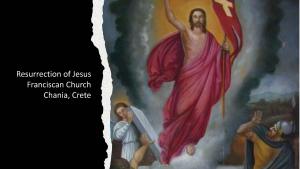
Note Paul’s term for physical body, soma psychikon. That is an ensouled body, a body with a mind. Body and soul along with our intelligence die. Kaput. Kafinished. Over. No cybernetic immortality here.
Paul stresses that what is redeemed is healed, renewed, transformed. In the resurrection we will be made ready by God’s grace for eternal life. That’s what soma pneumatikon indicates, a spiritual body.
To be spiritual does not mean to be ethereal. The resurrected body is still a body, only healed.
Conclusion
Let me mention again that I am editing a book with Arvin Gouw and Brian Patrick Green, Religious Transhumanism and Its Critics (Roman & Littlefield, Lexington, 2022). Watch for it.
Now, which box did you check?
Our transhumanist friends will attempt to make us immortal so we can live forever in this world, this fallen world. The biblical eschatological vision, in contrast, anticipates a transformation of the world coincidental with our resurrection. Cosmic eschatology and personal eschatology coincide. “Eschatology has always to be both universal and individual,” says Wolfhart Pannenberg rightly (Pannenberg 1991-1998, 3:543). The consummation of God’s redemptive work for the whole of the cosmos provides the backdrop for our personal resurrection from the grave’s oblivion. Jesus’ Easter resurrection is a prolepsis of your and my resurrection.
Reformed theologian and bioethicist Ronald Cole-Turner, sets up the parallel between H+ and the biblical promise. “Technology offers to give us what we want, or at least what most of us think we want—longer life, youthful bodies, greater health, and mental ability. Christianity invites us to give up what we want, indeed to give up life itself, as the one condition for real life” (Cole-Turner 2009, 58).
The New Testament message is that the God who raised Jesus from the dead on the first Easter will greet us on the other side of death’s darkness. The light beyond death’s darkness is the light of the world, the brilliance of a redeemed cosmos. This is the gospel’s call to trust, to trust when we cannot be in control.
▓
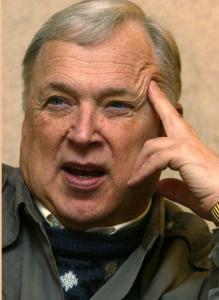 Ted Peters directs traffic at the intersection of science, religion, and ethics. Peters is a professor at the Graduate Theological Union (GTU), where he co-edits the journal, Theology and Science, on behalf of the Center for Theology and the Natural Sciences (CTNS), in Berkeley, California, USA. He is author of Playing God? Genetic Determinism and Human Freedom (Routledge, 2nd ed., 2002) and editor of AI and IA: Utopia or Extinction? (ATF 2019). Watch for Ted’s forthcoming book, The Voice of Public Christian Theology (ATF 2022). Visit his website: TedsTimelyTake.com.
Ted Peters directs traffic at the intersection of science, religion, and ethics. Peters is a professor at the Graduate Theological Union (GTU), where he co-edits the journal, Theology and Science, on behalf of the Center for Theology and the Natural Sciences (CTNS), in Berkeley, California, USA. He is author of Playing God? Genetic Determinism and Human Freedom (Routledge, 2nd ed., 2002) and editor of AI and IA: Utopia or Extinction? (ATF 2019). Watch for Ted’s forthcoming book, The Voice of Public Christian Theology (ATF 2022). Visit his website: TedsTimelyTake.com.
▓
Bibliography
Cole-Turner, Ronald. 2009. “Extreme Longevity Research: A Progressive Protestant Perspective.” In Religion and the Implications of Radical Life Extension, by ed Calvin Mercer, 50-62. New York: Macmillan Palgrave.
DeGrey, Aubry. 2009. “Radical Life Extension: Technological Aspects.” In Religion and the Implications of Radical Life Extension, by eds. Derek F. Mather and Calvin Mercer, 13-24. New York: Macmillan Palgrave.
Garcia-Barranquero, Pablo. 2021. “Transhumanist Immortality: Understanding the Dream as a Nightmare.” Scientia et Fides 9:1 177-196.
Hauskeller, Michael. 2013. Better Humans? Understanding the Enchantment Project. London: Routledge.
Herzfeld, Noreen. 2002. In Our Image: Artificial Intelligence and the Human Spirit. Minneapolis MN: Fortress.
Koch, Christoph. 2013. “The End of the Beginning for the Brain.” Science 339:6121 759-760.
Kurzweil, Ray. 2005. The Singularity if Near: When Humans Transcend Biology. New York: Penguin.
Meilaender, Bilbert. 2013. Should We Live Forever? The Ethical Ambiguities of Aging. Grand Rapids MI: Wm B Eerdmans.
Mercer, Calvin. 2015. “Whole Brain Emulation Requires Enhanced Theology, and a Handmaiden.” Theology and Science 13:2 175-186.
Mercer, Calvin, and Tracy Trothen. 2021. Religion and the Technological Future: An Introduction to Biohacking, Artificial Intelligence, and Transhumanism. New York: Macmillan Palgrave.
Pannenberg, Wolfhart. 1991-1998. Systematic Theology, 3 Volumes. Grand Rapids MI: Wm B Eerdmans.
Peters, Ted. 2017. “Where There’s Life There’s Intelligence.” In What is Life? On Earth and Beyond, by ed Andreas Losch, 236-259. Cambridge: Cambridge University Press.
Polkinghorne, John. 2019. What can we hope for? Cambridge : Cambridge University Press.
Saxena, Neela Bhattacharya, 2020. “AI as Awakened Intelligence: Buddha, Kurzweil and the Film ‘Her’.” Theology and Science 18:1 (February) 74-85.
Shermer, Michael. 2016. “Radical Life Extensiion is NOT around the Corner.” Scientific American 316:10 84.
Tillich, Paul. 1951-1963. Systematic Theology. 1st. 3 Volumes: Chicago: University of Chicago Press.
Wright, NT. 2007. “Cosmic Future: Progress or Despair?” In From Resurrection to Return: Perspectives from Theology and Science on Christian Eschatology, by Christine Ledger, and Stephen Picard, eds James Haire, 5-31. Adelaide: ATF Press.
—. 2006. Evil and the Justice of God. London: SPCK.
Young, Simon. 2006. Designer Evolution: A Transhumanist Manifesto. Amherst NY: Prometheus Books.


